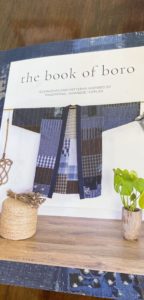Book Review
The Book of Boro by Susan Briscoe
David and Charles, London, publisher
Reviewer: Cathy Koos

Susan Briscoe invites readers to come along on her boro journey, beginning with a 90-year-old, boro-patched Japanese work jacket she discovered rolled up in a bundle of old clothing.
Loosely translated, boro means rag, and should not be confused with sashiko, which is a stitching style. While the slow stitching movement frequently uses sashiko stitching, it is not boro. Boro embraces the Japanese mantra of mottaino, or do not waste. Well-repaired, a boro garment can serve four generations of wearers.
Briscoe tells us that vintage boro is increasingly rare and displays a subtlety of softened colors and aged fabrics. Exceedingly difficult to reproduce, vintage boro has become highly collectible.
“…boromono, as it is sometimes called, represented a desire to lovingly clothe their families and keep them warm in very harsh environments, such as the remote farming areas of northern Japan. It was an everyday repair. They could not afford or access new fabric, so they used recycled cloth to make what was needed. Piecing, stitching, and mending were once widespread throughout Japan, but remained important for longer in areas where new fabrics were not manufactured, so were scarce and expensive. Layers of patches, worn and torn, created a random, tactile beauty,” Briscoe relates.
Cotton fabric, Briscoe shares, was scarce in northern Japan due to short summers and very cold winters, so second-hand fabric was highly valued. The only textile fiber grown in the north was hemp. While considered a luxury fabric, hemp was time consuming to process, indigo dye, and weave into fabric for busy farm families.
Often several women would collaborate on the purchase of a 50-pound bale of used fabric. Sorted and scrubbed, the worst fabric went to strips for braided ropes and woven rugs; middle grade for mending patches and household items; and the better fabrics went to garments.
To inspire readers to create their own boro designs, Briscoe includes schematics for projects ranging in size from bookmarks, coasters and miniature Hanten jackets to full sized jackets, messenger bags, and bed quilts.
I highly recommend this excellent book. Find a copy at your local bookseller.